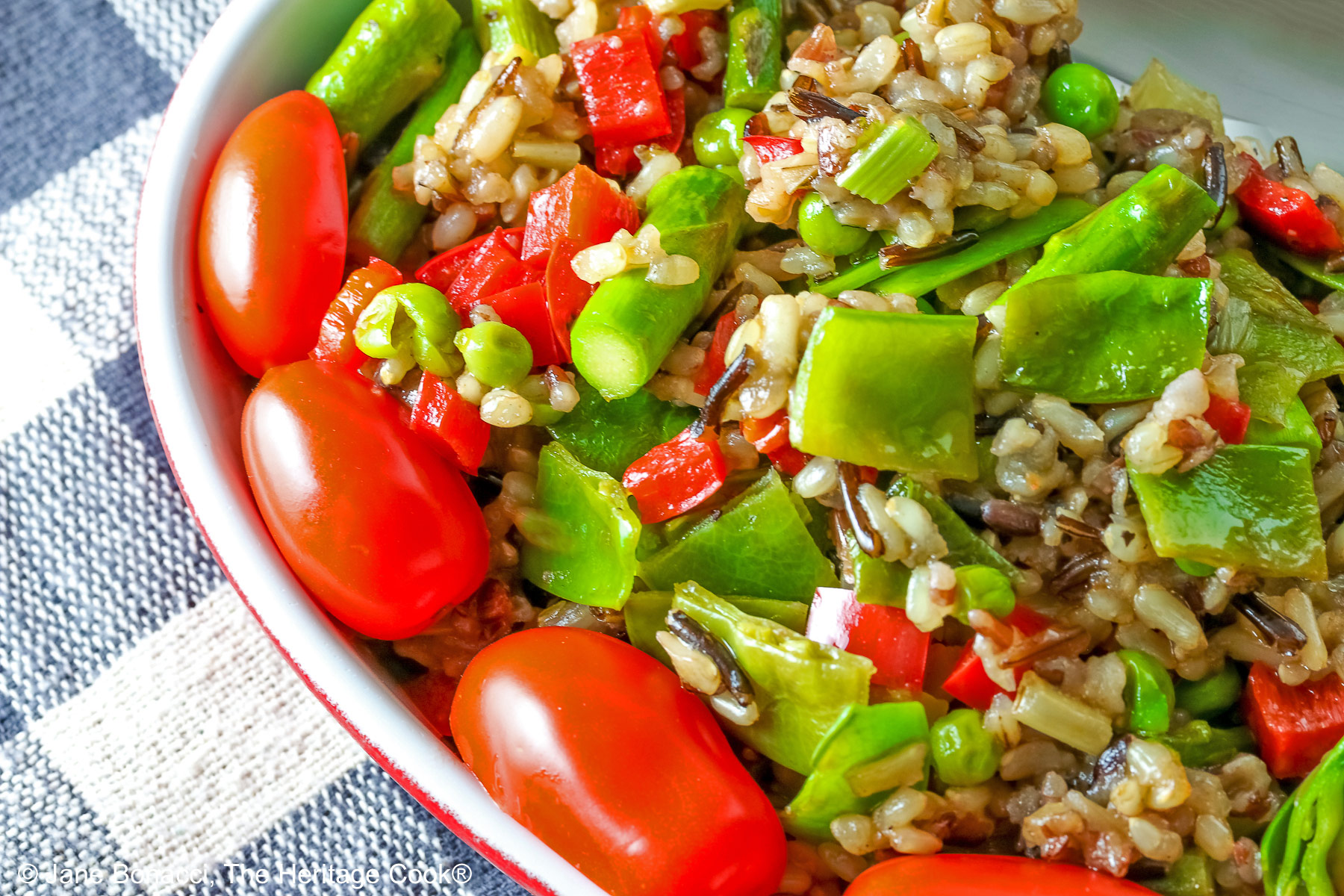
With this Brown and Wild Rice Pilaf the natural flavors of the variety of rices are enhanced by the broth and vegetables. If you haven’t already used a mixed rice blend, you will love it. This is one of my favorite recipes and has been for years.
I have a large collection of cookbooks that I’ve collected over the years. Some are well worn and others look brand new, but all of them have been read and loved. Yes, I’m one of that rare breed that actually reads cookbooks cover-to-cover like a novel.
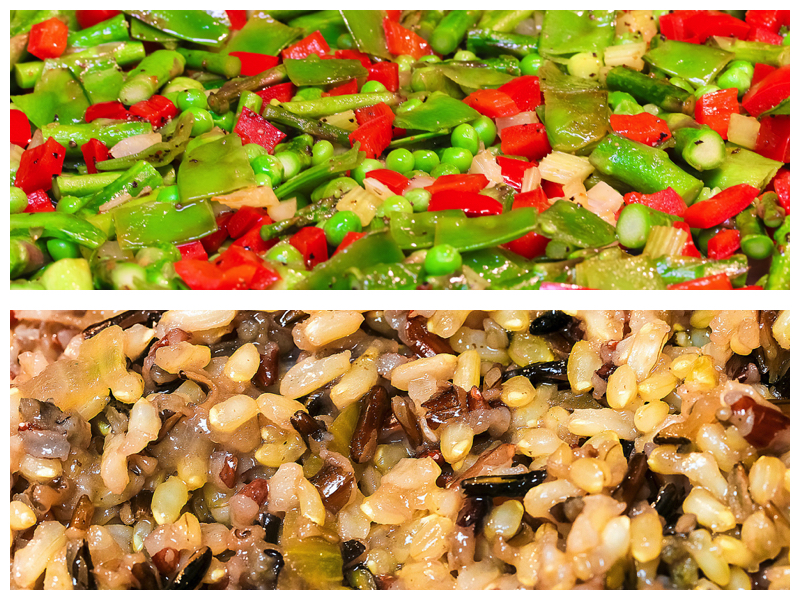
Top: Sautéing vegetables; Bottom: Cooked brown and wild rice blend
One day, after being told by a friend that I was in a cooking rut, I went searching for new recipes for an upcoming party. When I am deciding on menu items I think about the ingredients and how complementary they are to each other, the colors and how they will look on the plate, the nutritional value of each component, is there an array of textures, and above all the tastes – do I have a nice blend of flavors.
The human tongue is sensitive to four basic tastes … sweet, sour (acidic), bitter, and salt. Different areas of the tongue respond to different tastes. The front is sensitive to sweet, the sides to sour, the front and sides to salt, and the back to bitter. Try a fun experiment, keeping your tongue still, place some salt right in the middle. Unless your saliva dissolves and disperses it, you can’t taste it at all.
An ingredient that has multiple compounds in it will taste differently depending on what part of the tongue it hits. For example, on the tip of the tongue sugar substitute tastes sweet, but at the back of the tongue it can taste bitter.
All the senses of the body are involved when we eat … taste, touch, smell, sight, and sound, and the best dining experience is when all of them are involved.
We obviously think about the taste first when we think of food, but what about when you have a cold and can’t smell it? Food isn’t very appetizing without the wafting aromas. And when we bite into a crisp apple, the crunch is as important as the taste. It just wouldn’t be the same experience if there was no sound! If you serve nothing but pureed food, it’s boring. Add some crunchy lettuce, a rough wild grain, and a chewy piece of bread and suddenly it is texturally interesting.
It is said we eat with our eyes first. How a plate looks is very important to the overall satisfaction with the meal. You should have a variety of colors which guarantees you have a lot of nutrients. My mother used to say if the plate is “colorful and pretty” it will be healthy for you. Eat the rainbow!
When a friend challenged me to serve something new at an upcoming party, I wanted an interesting side dish to go with the pan-seared fish I had chosen as the main course. I love wild rice. I turned to my copy of “The New York Times Cookbook” by Craig Claiborne, an amazing collection of recipes from the former editor of the New York Time’s Dining and Wine Section. Like the venerable “Joy of Cooking”, and more recently Mark Bittman’s award winning “How To Cook Everything”, these are reference books that should be in every cook’s collection.
No matter what you’re thinking of cooking, there are most likely recipes to inspire you in any of these books. World cuisines, ingredients, techniques, and courses are covered in depth. From family dinners to the fanciest of dinner parties, you’ll find recipes you will love. I found today’s recipe and have been making it for my family, friends, and catered events ever since.
Did you know that wild rice is not rice at all but a grass? It grows in areas of shallow water, so prevalent in the state of Minnesota that it is the official state grain.
Surprisingly the Central Valley of California is the other main producer of wild rice. It is naturally gluten-free and high in protein, potassium, B-complex vitamins, and dietary fiber. Complex carbohydrates take longer for the body to digest keeping you feeling full longer and don’t spike your blood sugar.
Delicious and good for you, what more could you ask for! Adding sautéed vegetables adds even more nutrients. flavor, and textures to the dish as well as bright colors. Try a blend the next time you’re thinking of serving rice for dinner. You may find that it is so much more interesting and delicious than plain white rice that you’ll never go back!
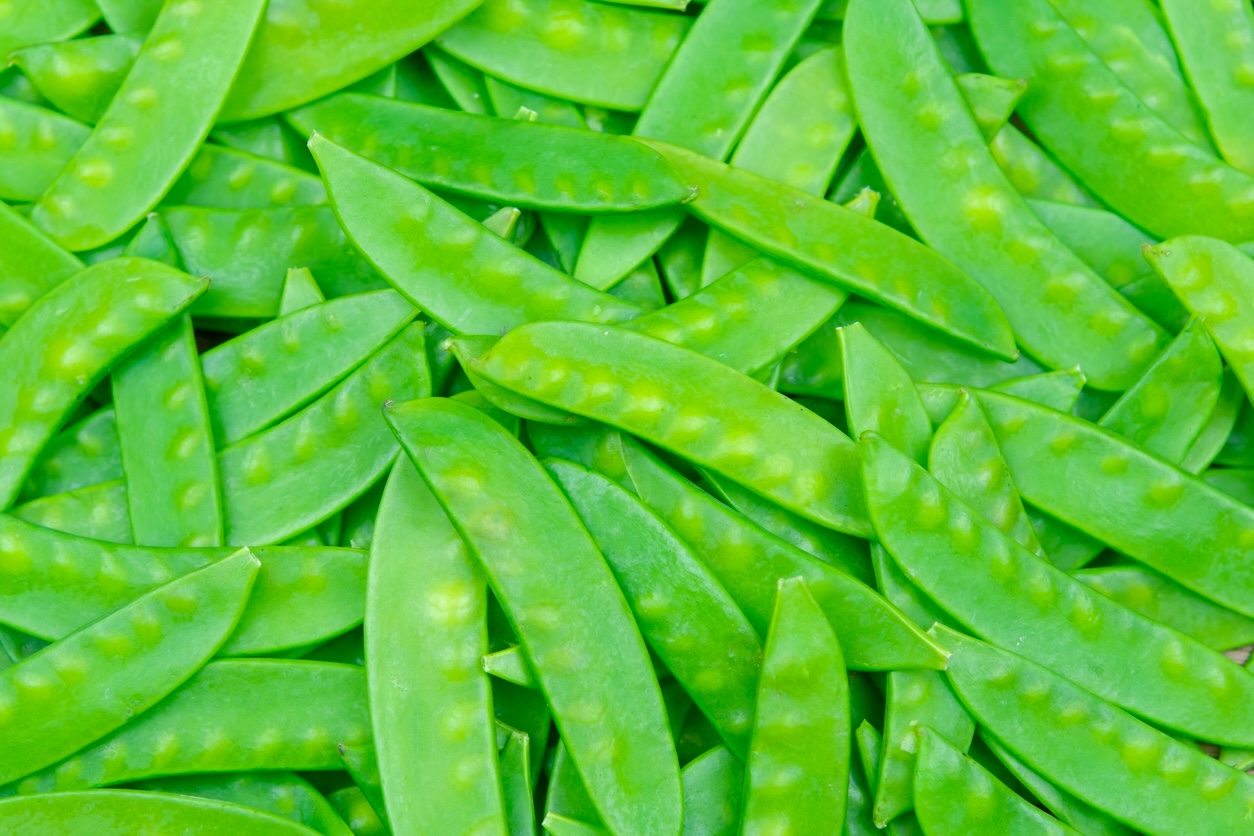
Fresh raw snow peas ready to be prepped for the recipe
This Brown and Wild Rice Pilaf is a delightful dish that works either as a delicious side dish or with a few more vegetables it can become a luscious vegetarian/vegan main course. Flexible and delectable, this is a winning recipe!
If you try this recipe, let me know! Please leave a star rating in the recipe card, comment below, and don’t forget to snap a pic and tag it @theheritagecook on Instagram! Seeing your creations makes my day and I love hearing from you!
Ingredients needed for Brown and Wild Rice Pilaf:
- Rice: olive oil, shallot, brown and wild rice blend, salt, vegetable broth
- Vegetables: olive oil, shallot, snow peas, celery, red bell pepper, asparagus, mushrooms, peas, cherry tomatoes, salt, pepper
PRO Tip:
Using a wild rice blend with brown or other rice types is a great way to save some money(wild rice is expensive on its own) and have a variety of textures in one dish. Store brown and wild rice in airtight containers in the refrigerator. Unlike white rice, which can be stored at room temperature for many years, brown and wild rice have natural oils in the outer layers that can spoil and turn rancid. Always smell rice before cooking and throw it away if it doesn’t smell good.
PRO Tip:
This vegetable laden rice dish is positively delightful with tons of flavor and texture. Because of the blend of grains, this will take about an hour to cook and assemble, be prepared for that length of cooking time.
How to make Brown and Wild Rice Pilaf:
- Make the Rice: Rinse the rice and drain. Sauté shallots then stir in the rice, salt, and broth. Bring to a boil, cover, and lower the heat to hold a low simmer. Cook 35 to 45 minutes until the liquid is absorbed and the rice is tender, or according to package directions. Leave it covered, move off the heat and let rest about 10 minutes.
- Sauté the Vegetables: Sauté together the shallots, snow peas, celery, and bell peppers; cook to crisp-tender. Stir in the peas. Add mushrooms (if using) and cook until most of the liquid has evaporated.
- Combine the Ingredients: Transfer the finished rice to a large bowl and fluff with two forks. Add the sauteed vegetables and toss until well combined. Mix in the tomatoes and add salt and pepper to taste. Transfer to an ovenproof serving dish. Cover and keep warm in a very low oven until ready to serve.
- Store, covered, in the refrigerator. Reheat before serving.
PRO Tip: Toasting Nuts
You can toast nuts two ways, in the oven or on the stove. The oven gives a more even toasting without the need for stirring, but can burn if you aren’t watching carefully. In a skillet, you can watch them more closely, but they need a lot of attention because they turn from perfectly toasted to burned and inedible in a second. Make sure the nuts are all similarly sized so they cook more evenly.
Bake in the oven at 350°F for about 8 to 10 minutes, shaking the baking sheet halfway through. All ovens vary, so check the nuts often. Or toast them in a skillet over medium to medium-high heat, stirring constantly for 5 to 7 minutes. As soon as they start to turn brown, remove from the heat and let the residual heat of the pan finish toasting them.
Recommended Tools (affiliate links; no extra cost to you):
Gluten-Free Tips:
You will get the best and most consistent results by using a digital kitchen scale and weighing your ingredients, especially when you are baking. And use grams, they are much more accurate than pounds and ounces.
All recommended ingredients are gluten-free as of the writing of this article. Always check to be sure the products haven’t changed and are still safe to consume.
Brown and Wild Rice Pilaf (GF)
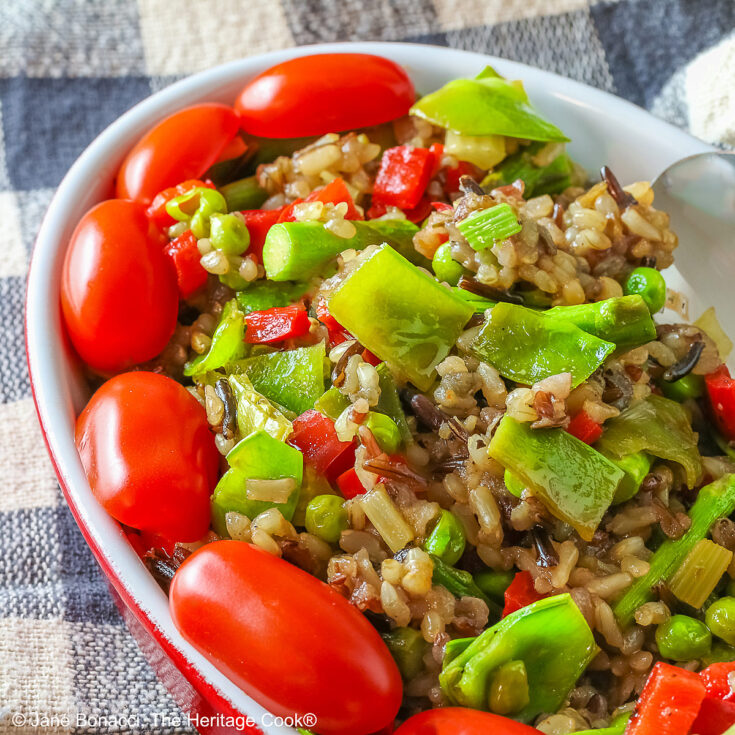
This Brown and Wild Rice Pilaf is a delightful dish that works either as a delicious side dish or with a few more vegetables it can become a luscious vegetarian main course. Flexible and delectable, this is a real winning recipe!
Ingredients
Rice
- 1 tbsp olive oil
- 1 shallot, finely chopped
- 1 cup (198g) brown and wild rice mix or plain wild rice
- 1 tsp kosher salt
- 2 cups (473 ml) vegetable broth
Vegetables
- 2 tbsp olive or canola oil
- 1 shallot, finely chopped
- 1/4 lb (113 mg) snow peas, ends and strings removed, cut into 1/2-inch pieces
- 2 stalks celery, finely chopped
- 1 large red bell pepper, seeded and finely chopped
- Asparagus spears, cut into small bite-size pieces, or any other seasonal vegetables you like
- 4 large mushrooms, thickly sliced or quartered, optional
- 1/2 cup (118 ml) frozen peas
- 10 to 15 cherry tomatoes, sliced in half or quartered
- 1/2 tsp salt
- 1/4 tsp pepper
- Toasted sliced almonds, optional for garnish
Instructions
1. Make the Rice: Rinse the rice under running water and drain well. Heat the oil in a large saucepan (with a lid). Sauté the shallots over medium heat until softened. Add the rice, tossing to coat with the oil. Stir in the salt and broth and bring to a boil.
2. Stir once, cover with a lid, and reduce the heat to low. Simmer 35 to 45 minutes until liquid is absorbed and rice is tender, or according to package directions. Remove from heat, leave the lid on, and let sit undisturbed for about 10 minutes. If there is still liquid in the bottom of the pan, place it over heat and bring to a boil, cooking until the liquid has evaporated.
3. Sauté the Vegetables: When the rice is almost done cooking, heat the oil in a large skillet over medium heat. Add the shallots, snow peas, celery, and bell peppers. Cook, stirring occasionally, for a minute or two. Add asparagus (or other vegetables) and cook, tossing often, about 1 to 2 minutes or until crisp tender. Add mushrooms if using. Sauté only until mushrooms are tender and most of their liquid has evaporated. Stir in the peas.
4. Combine the Ingredients: Transfer the rice to a large bowl and fluff with two forks to separate the grains. Toss the sauteed vegetables with the rice, mix in the tomatoes, add salt and pepper to taste, and transfer to an ovenproof serving dish. Cover and keep warm in a very low oven until ready to serve. If using, sprinkle top with the toasted almonds and serve.
Recipe found at www.theheritagecook.com
Notes
You will get the best results by using a digital kitchen scale and weighing your ingredients, especially when you are baking. And use grams, they are much more accurate than pounds and ounces.
All recommended ingredients are gluten-free as of the writing of this article. Always check to be sure the products haven’t changed and are still safe to consume.
Adapted from a recipe in The New York Times Cookbook by Craig Claiborne.
Nutrition Information:
Yield:
6Serving Size:
1Amount Per Serving: Calories: 274Total Fat: 14gSaturated Fat: 1gTrans Fat: 0gUnsaturated Fat: 12gCholesterol: 2mgSodium: 563mgCarbohydrates: 30gFiber: 7gSugar: 8gProtein: 10g
The nutritional information for recipes on this site is calculated by online tools and is merely an estimate. If you need nutritional calculations for medical reasons, please use a source that you trust.
If you enjoyed this recipe, be sure to follow me on social media so you never miss a post:
Create a New Tradition Today!
Welcome! The suggestions here are not intended as dietary advice or as a substitute for consulting a dietician, physician, or other medical professional. Please see the Disclaimers/Privacy Policy page for additional details. Unauthorized use, distribution, and/or duplication of proprietary material from The Heritage Cook without prior approval is prohibited. If you have any questions or would like permission, please contact me. We participate in the Amazon Services LLC Associates Program, an affiliate advertising program designed to provide a means for sites to earn advertising fees by advertising and linking to amazon.com. As an Amazon Associate, I earn a small amount from qualifying purchases without any additional cost to you. This page may contain affiliate links. The author makes no claims regarding the presence of food allergens and disclaims all liability in connection with the use of this site. This post was first shared in July 2010. The article was updated in 2025.
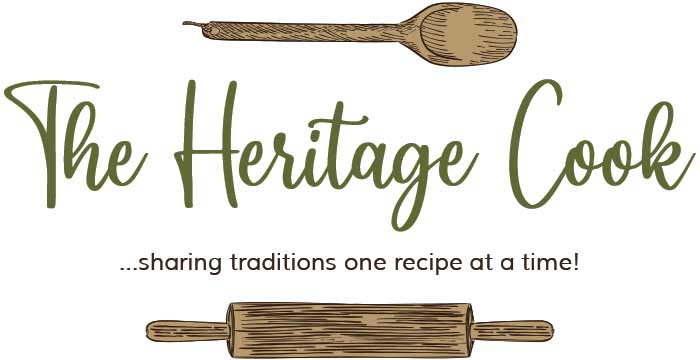
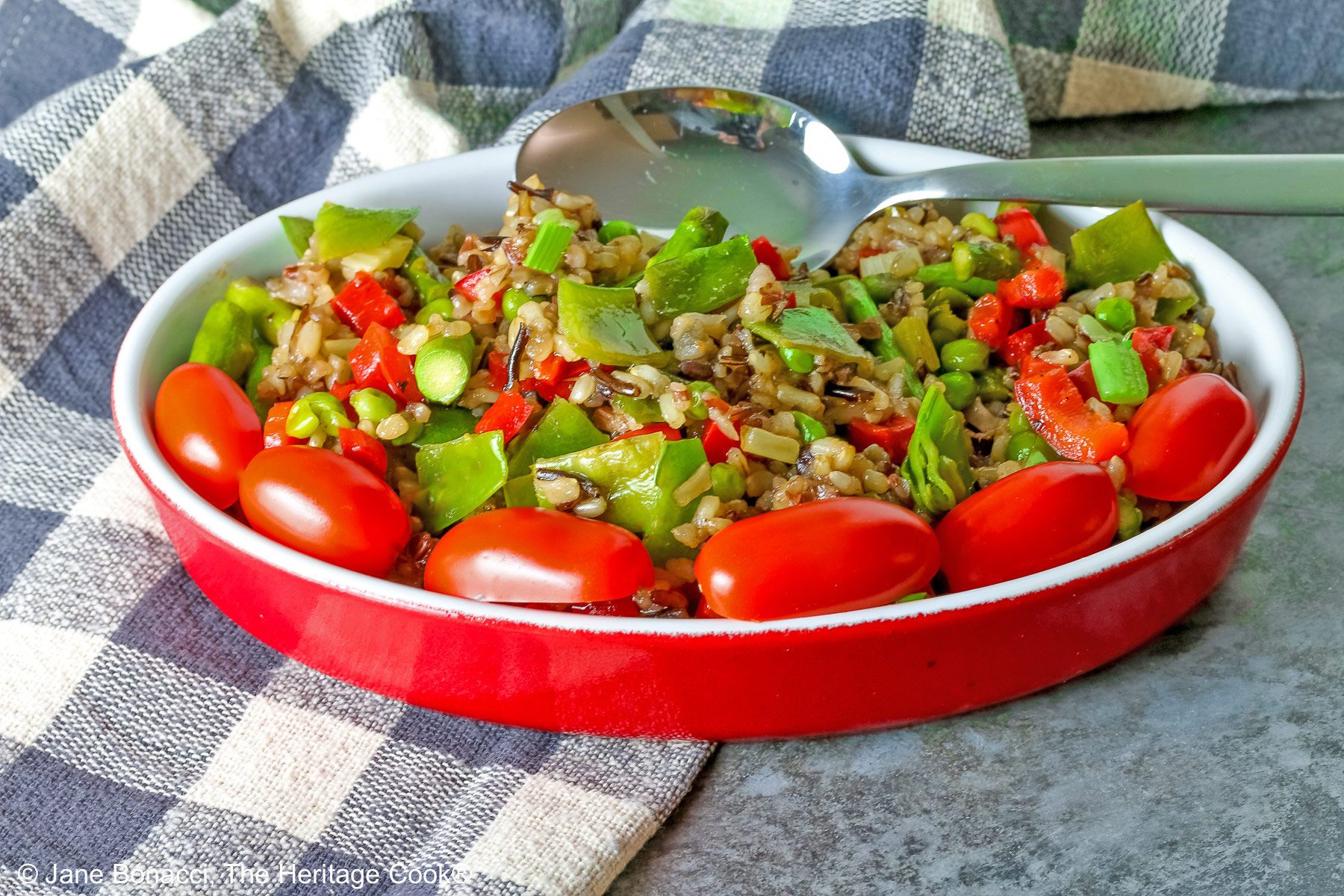
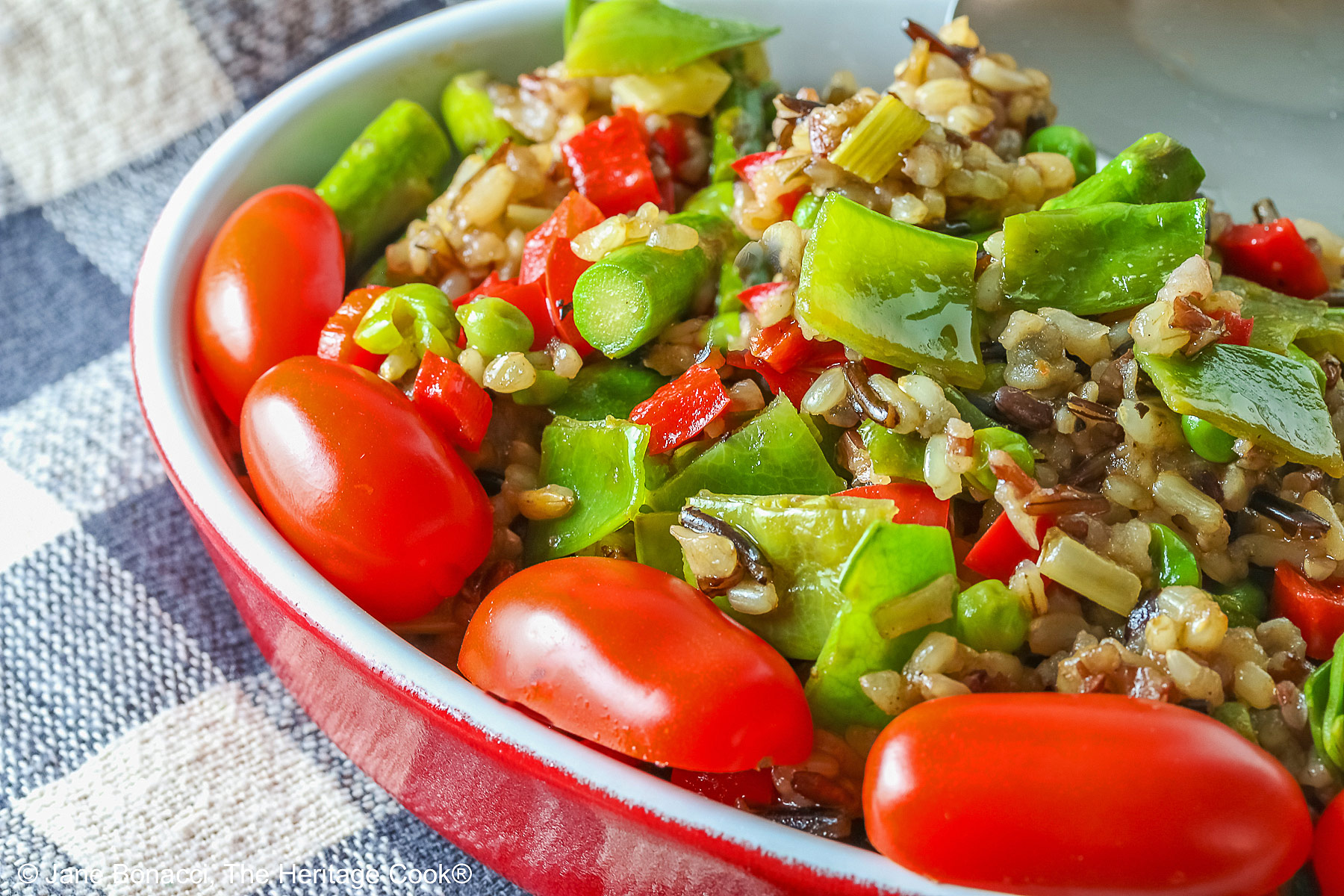
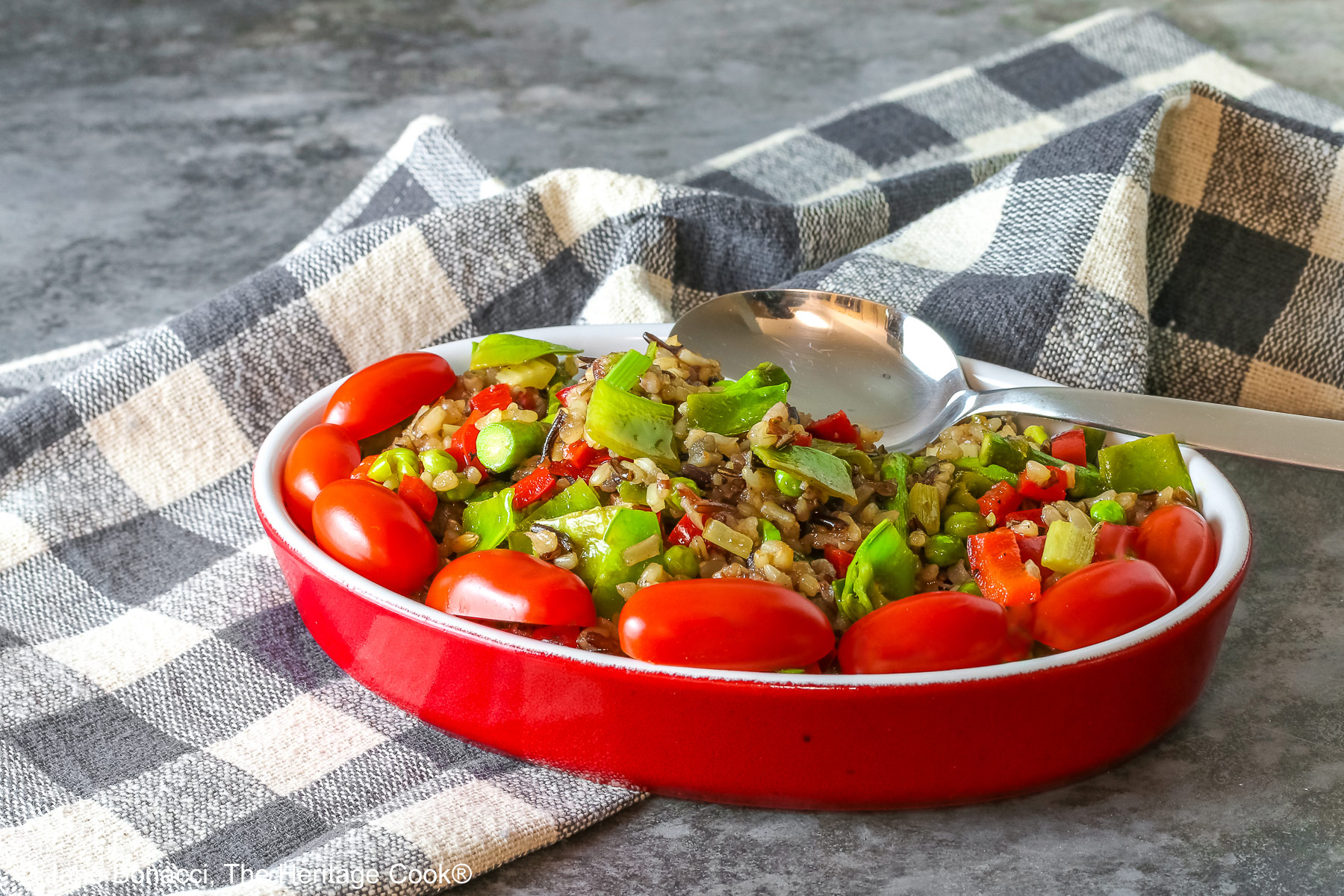
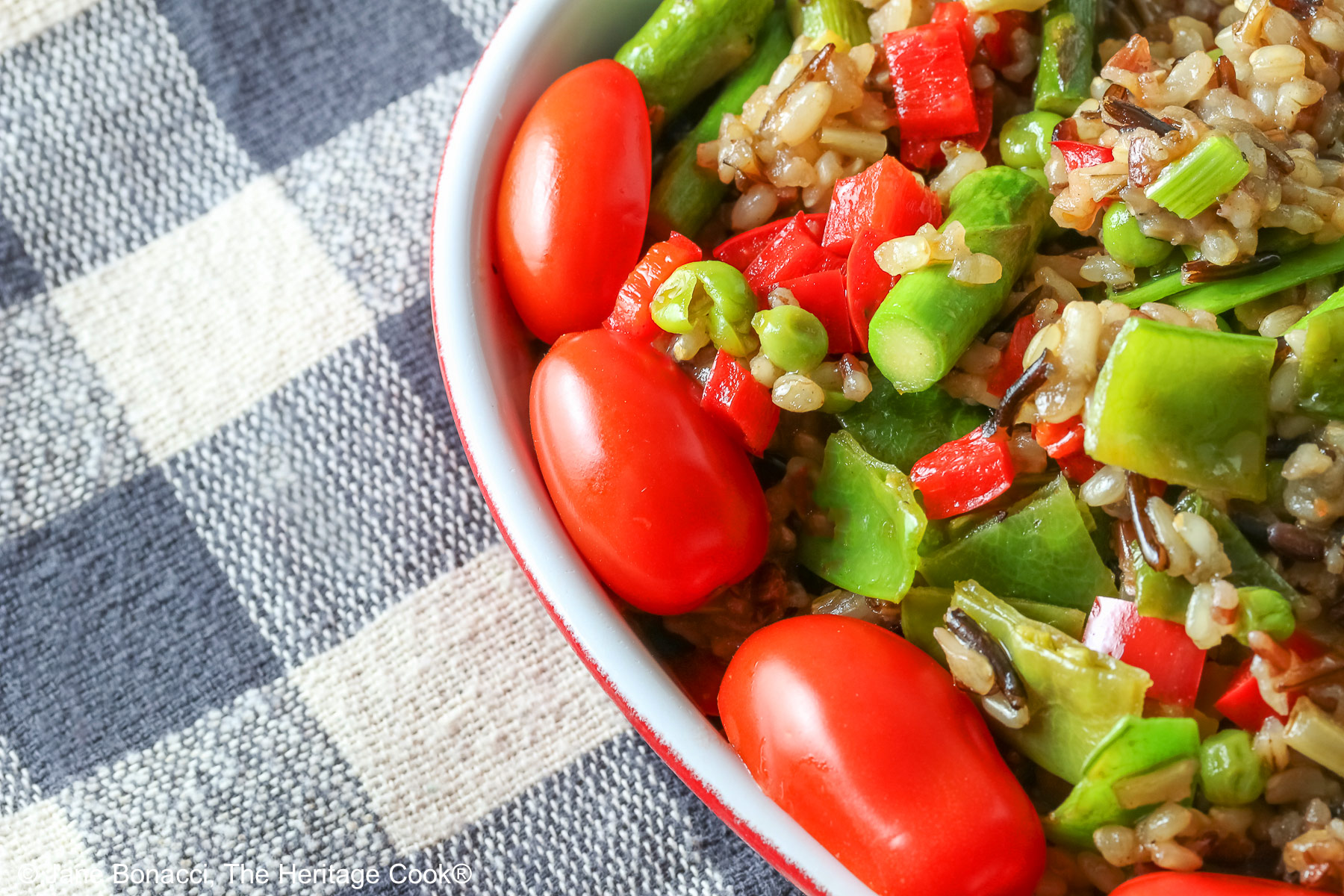

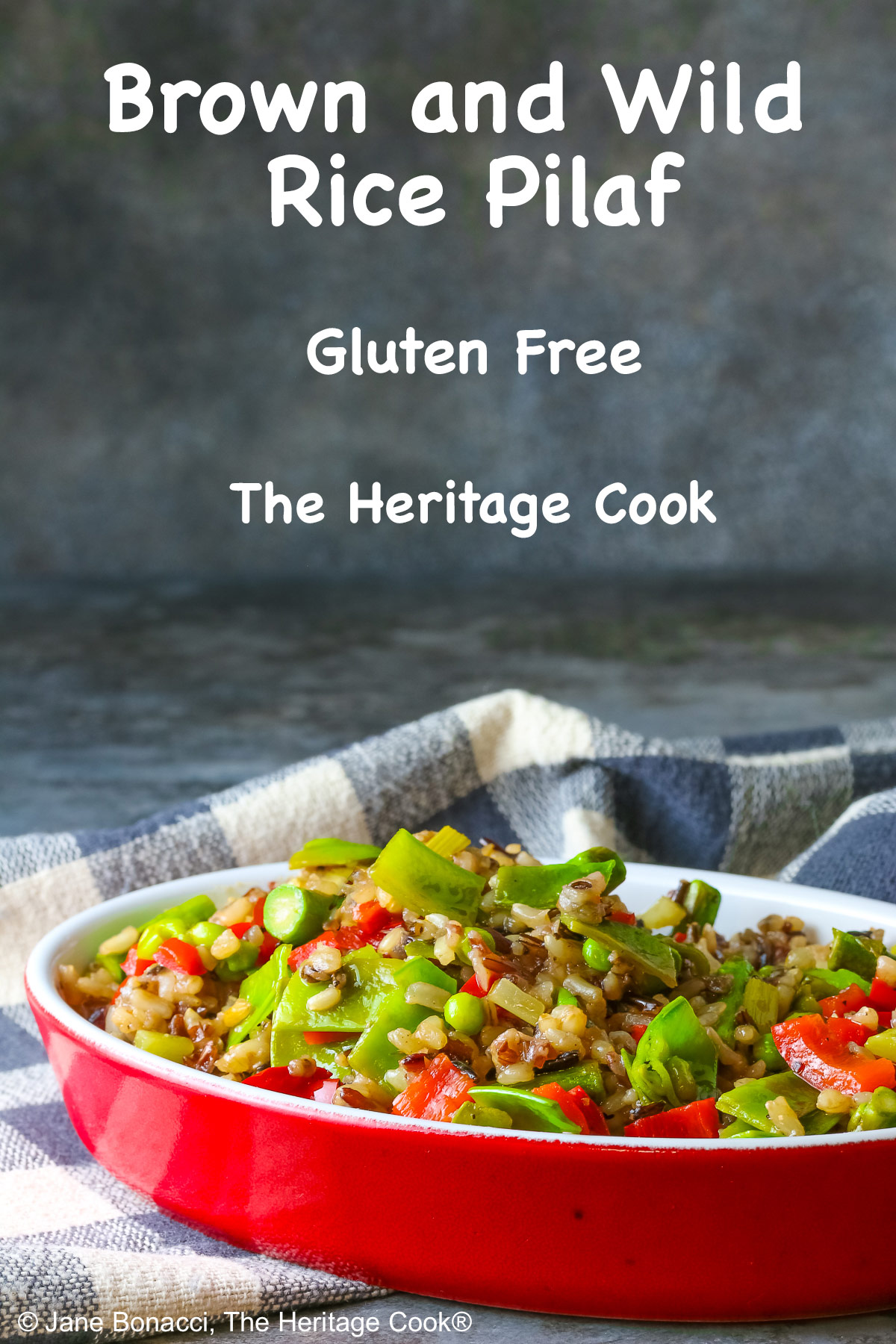

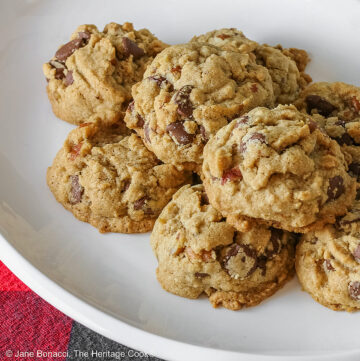
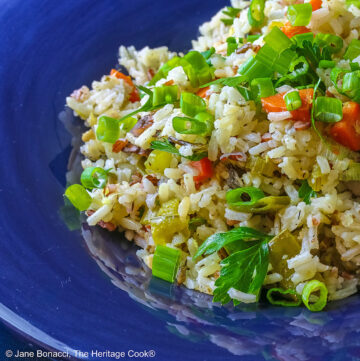

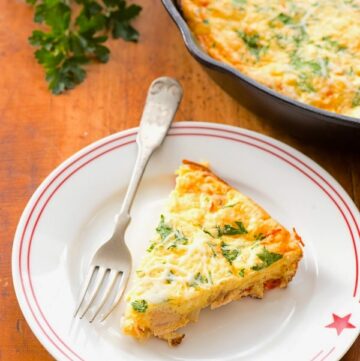
Carissa
I am a huge fan of wild rice, and I had no idea that it’s actually a grass. Hhmm.. kind of sneaky like the little quinoa being a ‘green’ and not a grain. Thanks for sharing some good recipe resources. I read cookbooks from cover to cover also. I love it.
Jane Bonacci, The Heritage Cook
Hi Carissa,
Welcome! It’s funny how producers decide to market items – you’re never sure exactly what it is, LOL! I hope you enjoy the recipes. You can subscribe to the blog to get emails whenever I post a new item (I post 5 days a week) and/or you can join my Fan Page on Facebook and get notices that way! Either way I’m happy to have you join us.
Happy Cooking!
Jane
Magali Goren
Thanks for the post. I am always looking for ways to improve my gardening and cooking skills. My family loves eating real food.
Jane Bonacci, The Heritage Cook
I’m glad that your family enjoys the results of your gardening. I’ve enjoyed your tips on growing tomatoes!
Lamar Manweiler
I found your entry interesting thus I’ve added a Trackback to it on my weblog :)…
Sharron Richert
Sweet, that’s exactly what I was looking for! You just saved me alot of work
Jane Bonacci, The Heritage Cook
Always happy to help!
Tes
Wow the snow peas look really beautiful. The recipe sounds really yummy. It looks so healthy and nutritious 🙂
Jane Bonacci, The Heritage Cook
Hi Tes – it is a great recipe. I’ve been using it for many years and always get complements!
Cynthia Beck
Hi Jane,
Since my health protocol requires lots of fresh veggies and grains, I love it when you post interesting ways to cook them. I might even get off my lazy but and try this one!
Warm regards,
Cynthia
Jane Bonacci, The Heritage Cook
That makes me so happy Cynthia! This is one of my favorites and I’ve been making it for years. If you want to, take the same basic recipe and change out the grains for variety. You can make it with barley, farro, quinoa, couscous, etc. You’ll just have to adjust the cooking time and liquid to grain ratio as needed. Feel free to add more veggies and the ones you love. Some ideas would be lightly steamed or sauteed cauliflower, broccoli, squash, cucumber, bell peppers, onions, shallots, spinach, chard, carrots/celery of course, celery root, jicama, etc. Nearly limitless possibilities.